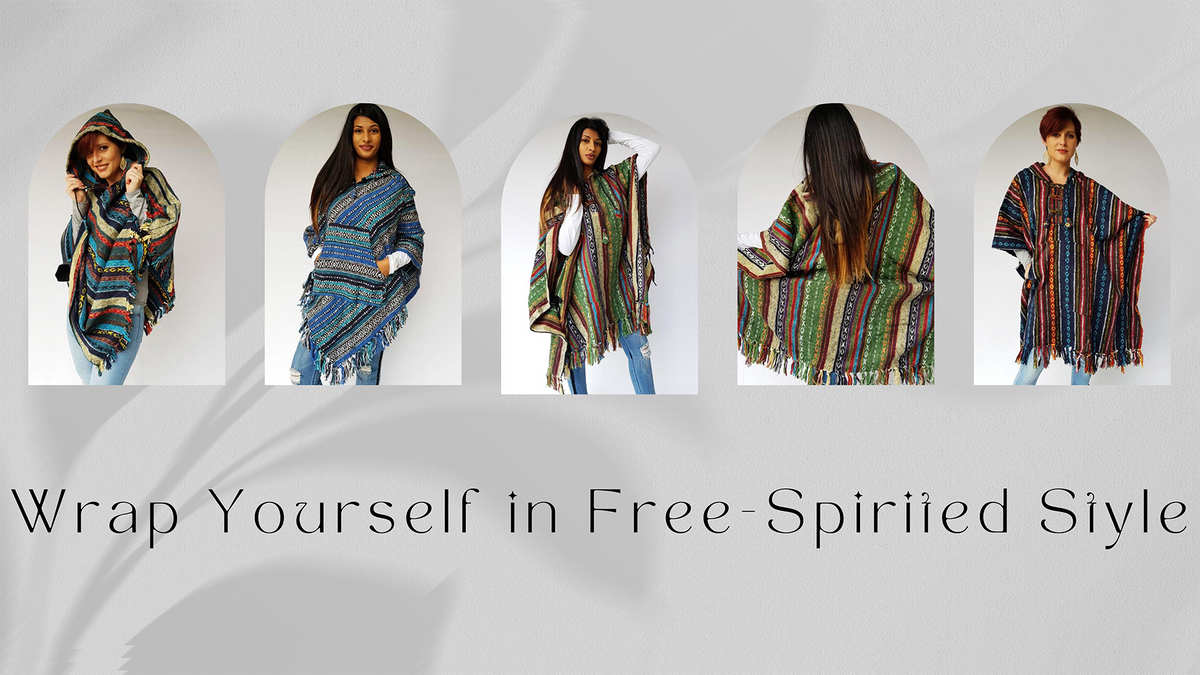
Ponchos can be traced back to pre-Hispanic times, where they were worn by indigenous people in the Andes region of South America. These early ponchos were primarily made from woven fibres such as alpaca and llama wool. They were simple rectangular pieces of fabric with a hole in the centre for the head to pass through, providing protection from the harsh mountain climates. The design allowed for easy movement and served as a versatile garment that could be used as a blanket or a piece of outerwear.

Over time, the poncho made its way to different parts of the world, adapting to the unique cultures and fashion sensibilities of each region. One notable variation is the Mexican-style hippie poncho, popularized during the 1960s counterculture movement. These ponchos were often made from woven cotton and featured vibrant colours and intricate patterns. They became synonymous with the free-spirited hippie lifestyle, representing a rejection of mainstream fashion and a celebration of individuality.
What makes ponchos a staple in the hippie closet is their versatility and bohemian charm. They can be effortlessly paired with various outfits to create a unique and laid-back look. For a casual ensemble, you can wear a Mexican-style poncho over a simple t-shirt and jeans, instantly adding a pop of colour and cultural flair. For a more eclectic vibe, layer it over a flowy maxi dress and accessorize with chunky jewellery and a wide-brimmed hat. The possibilities are endless, and the poncho allows for personal expression and creativity in styling.
Beyond the realm of fashion, ponchos have also found their place in practical and outdoor settings. Their ability to provide warmth and protection from the elements makes them a popular choice for camping trips, festivals, and other outdoor activities. Additionally, they are a convenient travel companion, as they can be easily folded and packed, taking up minimal space in a suitcase.
When it comes to fabrics, ponchos are available in a wide range of options to suit different preferences and climates. Traditional ponchos are still crafted from natural fibres like wool, alpaca, and cashmere, known for their insulation properties and durability. However, for those seeking lighter alternatives, ponchos made from synthetic fabrics such as acrylic, polyester, and fleece are also popular choices. These materials offer a lightweight and more affordable option while still providing warmth and comfort.


In conclusion, the history of ponchos is a testament to the enduring nature of this versatile garment. From its origins in ancient civilizations to its embodiment of the hippie fashion movement, the poncho has evolved and adapted to different cultures and styles. Whether you opt for a Mexican-style hippie poncho made from woven cotton or a modern synthetic variant, the poncho remains a fashion staple that can be worn in various settings and paired with different outfits.

The cultural significance of the Mexican-style hippie poncho cannot be understated. Its vibrant colours, intricate patterns, and woven cotton fabric capture the essence of Nepalese craftsmanship. These ponchos often feature geometric designs, tribal motifs, or traditional patterns, reflecting the rich cultural tapestry of the region. Wearing a hippie-style poncho not only adds a splash of colour to your wardrobe but also pays homage to the artistic traditions of the people of Nepal.
For the free-spirited hippie, the poncho embodies the ideals of individuality, nonconformity, and a connection to nature. The relaxed, loose-fitting silhouette of the poncho allows for freedom of movement, mirroring the carefree spirit of the hippie movement. By wearing a poncho, hippies can express their bohemian lifestyle and their appreciation for diverse cultures and alternative fashion choices.


When it comes to styling ponchos, the possibilities are endless. Apart from the classic pairing of a poncho with jeans or a maxi dress, you can experiment with different layers and textures to create unique looks. For a cosy winter outfit, layer a poncho over a turtleneck sweater and leggings, adding knee-high boots for a chic touch. In the warmer months, a lightweight poncho can be worn over a tank top and shorts, paired with sandals and a floppy hat for a relaxed, beachy vibe.
Accessories also play a crucial role in enhancing the overall look when wearing a poncho. Chunky statement jewellery, such as long pendant necklaces or oversized rings, can complement the bohemian aesthetic. Wide-brimmed hats, fringed bags, and ankle boots can further enhance the hippie-inspired ensemble.
The key is to experiment and let your personal style shine through.
In summary, the history of ponchos is a fascinating journey that spans centuries and continents. From their humble origins in ancient civilizations to their cultural significance in hippie fashion, ponchos have evolved and adapted to different styles and purposes. Whether you opt for a traditional woollen poncho or a vibrant hand woven cotton poncho, these versatile garments offer comfort, style, and a connection to diverse cultures. Embrace the hippie spirit, express your individuality, and let the poncho be a statement piece in your wardrobe.
Get yours here and get ready to celebrate your individuality.
